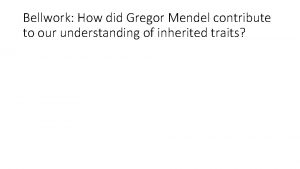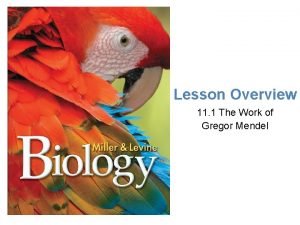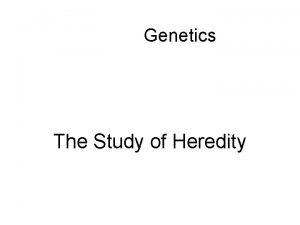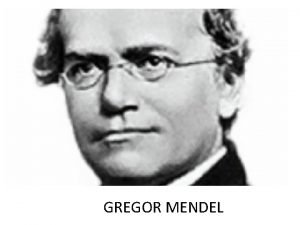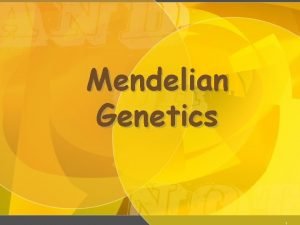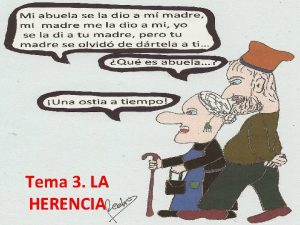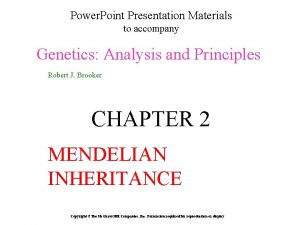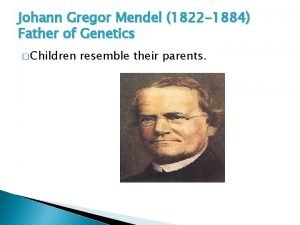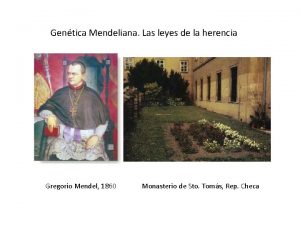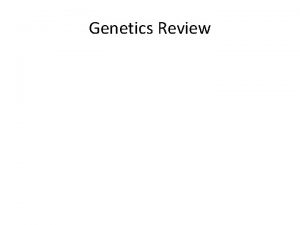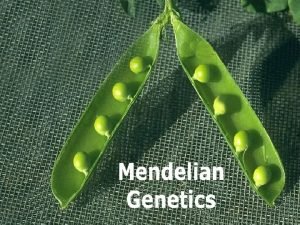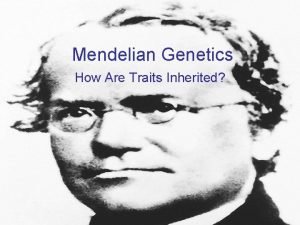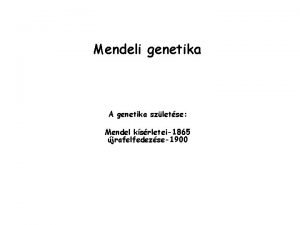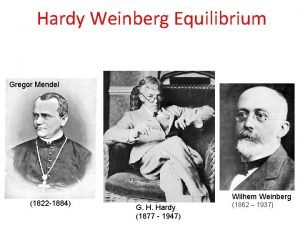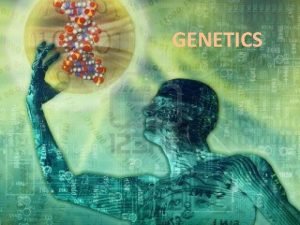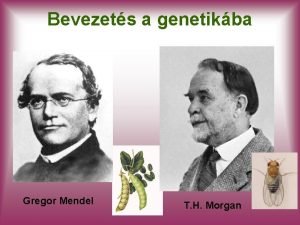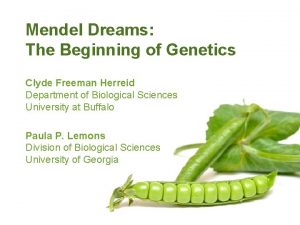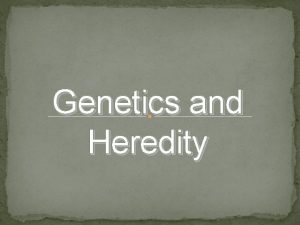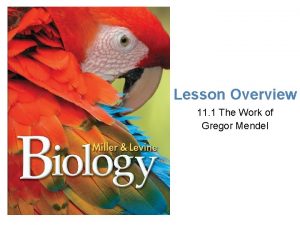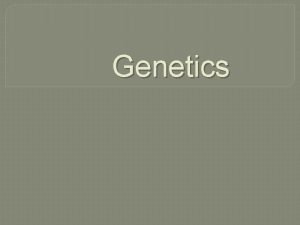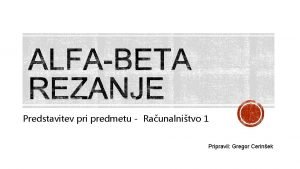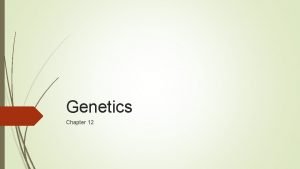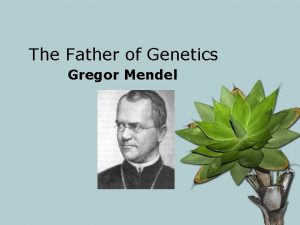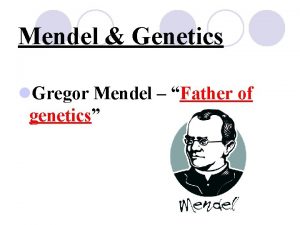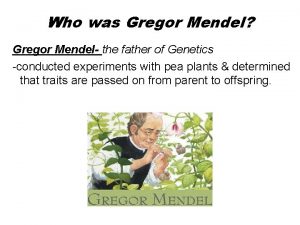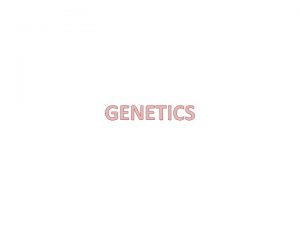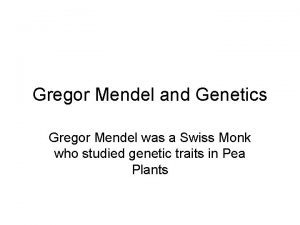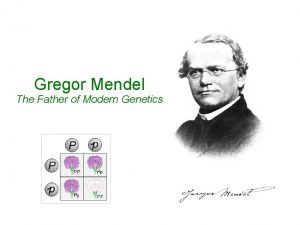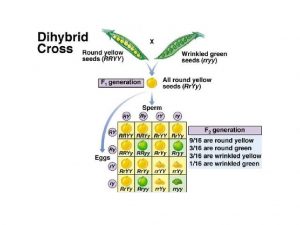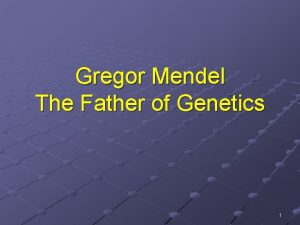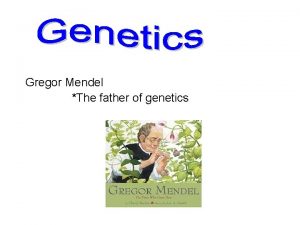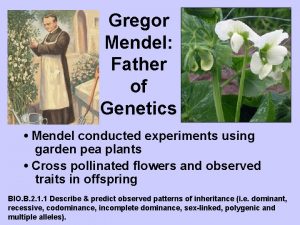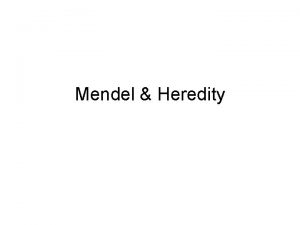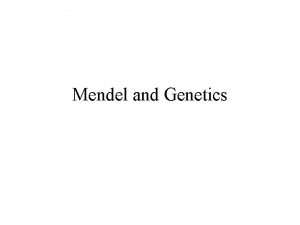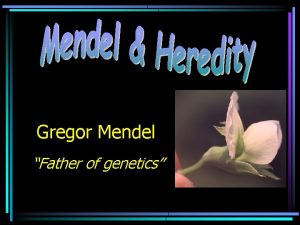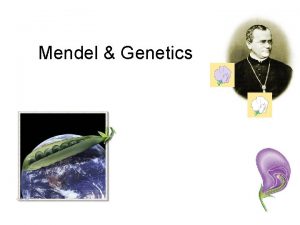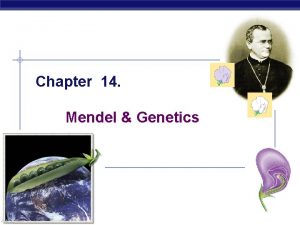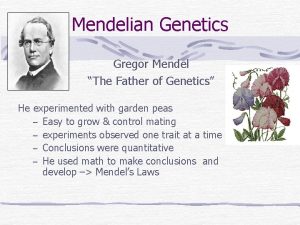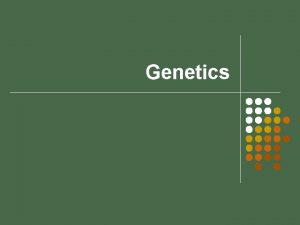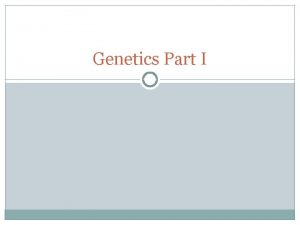Genetics Notes Who is Gregor Mendel Father of









































- Slides: 41

Genetics Notes Who is Gregor Mendel? “Father of Genetics” Principle of Independent Assortment – Inheritance of one trait has no effect on the inheritance of another trait

Traits • Genetics – study of how traits are passed from parent to offspring

• Traits are determined by the genes on the chromosomes. A gene is a segment of DNA that determines a trait.

• Chromosomes come in homologous pairs, thus genes come in pairs. Homologous pairs – matching genes – one from female parent and one from male parent • Example: Humans have 46 chromosomes or 23 pairs. One set from dad – 23 in sperm One set from mom – 23 in egg

• One pair of Homologous Chromosomes: Gene for eye color (blue eyes) Homologous pair of chromosomes Gene for eye color (brown eyes) Alleles – different genes (possibilities) for the same trait – ex: blue eyes or brown eyes

Dominant and Recessive Genes • Gene that prevents the other gene from “showing” – dominant • Gene that does NOT “show” even though it is present – recessive • Symbol – Dominant gene – upper case letter – T Recessive gene – lower case letter – t Dominant color Recessive color

Example: Straight thumb is dominant to hitchhiker thumb T = straight thumb t = hitchhikers thumb (Always use the same letter for the same alleles— No S = straight, h = hitchhiker’s) Straight thumb = TT Straight thumb = Tt Hitchhikers thumb = tt * Must have 2 recessive alleles for a recessive trait to “show”

• Both genes of a pair are the same – homozygous or purebred TT – homozygous dominant tt – homozygous recessive • One dominant and one recessive gene – heterozygous or hybrid Tt – heterozygous BB – Black Bb – Black w/ white gene bb – White

Homozygous= Pure • Pure dominant: the individual only has genes for the dominant trait. – Example: TT= a pure tall individual has only tall (T) genes. • Pure Recessive: the individual only has genes for the recessive trait – Example: tt= a pure short individual has only short (t) genes.

Heterozygous=Mixed • A heterozygous individual has one dominant gene and one recessive gene for a trait. The result is the dominant gene is the one expressed, or shown. – Example: Tt= heterozygous tall individual has both tall (T) and short (t) genes but looks tall.

Genotype and Phenotype • Combination of genes an organism has (actual gene makeup) – genotype Ex: TT, Tt, tt • Physical appearance resulting from gene make-up – phenotype Ex: hitchhiker’s thumb or straight thumb

Punnett Square and Probability • Used to predict the possible gene makeup of offspring – Punnett Square • Example: Black fur (B) is dominant to white fur (b) in mice 1. Cross a heterozygous male with a homozygous recessive female. Black fur (B) Heterozygous male White fur (b) Homozygous recessive female White fur (b)

Male = Bb X Female = bb b Male gametes - N (One gene in sperm) B b b Bb Bb bb bb Female gametes – N (One gene in egg) Possible offspring – 2 N Write the ratios in the following orders: Genotypic ratio = 2 Bb : 2 bb 50% Bb : 50% bb Genotypic ratio homozygous : heterozygous : homozygous Phenotypic ratio = 2 black : 2 white dominant 50% black : 50% white Phenotypic ratio dominant : recessive

Cross 2 hybrid mice and give the genotypic ratio and phenotypic ratio. B b B BB Bb bb Bb X Bb Genotypic ratio = 1 BB : 2 Bb : 1 bb 25% BB : 50% Bb : 25% bb Phenotypic ratio = 3 black : 1 white 75% black : 25% white

Example: A man and woman, both with brown eyes (B) marry and have a blue eyed (b) child. What are the genotypes of the man, woman and child? Bb X Bb Man = Bb B BB Bb bb Woman = Bb

Crossing involving 2 traits – Dihybrid crosses • Example: In rabbits black coat (B) is dominant over brown (b) and straight hair (H) is dominant to curly (h). Cross 2 hybrid rabbits and give the phenotypic ratio for the first generation of offspring. Possible gametes: Bb. Hh X Bb. Hh BH BH Gametes Bh Bh b. H BH bh bh Phenotypes - 9: 3: 3: 1 9 black and straight 3 black and curly 3 brown and straight 1 brown and curly BH Bh b. H bh BBHH BBHh Bb. HH Bb. Hh Bh BBHh BBhh Bb. Hh Bbhh b. H Bb. Hh bb. HH bb. Hh bh Bb. Hh Bbhh bb. Hh bbhh

• Example: In rabbits black coat (B) is dominant over brown (b) and straight hair (H) is dominant to curly (h). Cross a rabbit that is homozygous dominant for both traits with a rabbit that is homozygous dominant for black coat and heterozygous for straight hair. Then give the phenotypic ratio for the first generation of offspring. BBHH X BBHh Possible gametes: BH Phenotypes: 100% black and straight BH Bh BH BH BBHH Bh Gametes BBHh Gametes (Hint: Only design Punnett squares to suit the number of possible gametes. )

Sex Determination • People – 46 chromosomes or 23 pairs • 22 pairs are homologous (look alike) – called autosomes – determine body traits 1 pair is the sex chromosomes – determines sex (male or female) • Females – sex chromosomes are homologous (look alike) – label XX Males – sex chromosomes are different – label XY

• What is the probability of a couple having a boy? Or a girl? Chance of having female baby? 50% X X X XX XX Y XY XY Who determines the sex of the child? father

Incomplete dominance and Codominance • When one allele is NOT completely dominant over another (they blend) – incomplete dominance Example: In carnations the color red (R) is incompletely dominant over white (W). The hybrid color is pink. Give the genotypic and phenotypic ratio from a cross between 2 pink flowers. RW X RW R R W RR RW WW Genotypic = 1 RR : 2 RW : 1 WW Phenotypic = 1 red : 2 pink : 1 white

• When both alleles are expressed – Codominance Example: In certain chickens black feathers are codominant with white feathers. Heterozygous chickens have black and white speckled feathers.

Sex – linked Traits • Genes for these traits are located only on the X chromosome (NOT on the Y chromosome) • X linked alleles always show up in males whether dominant or recessive because males have only one X chromosome

• Examples of recessive sex-linked disorders: 1. colorblindness – inability to distinguish between certain colors You should see 58 (upper left), 18 (upper right), E (lower left) and 17 (lower right). Color blindness is the inability to distinguish the differences between certain colors. The most common type is red-green color blindness, where red and green are seen as the same color.

2. hemophilia – blood won’t clot

• Example: A female that has normal vision but is a carrier for colorblindness marries a male with normal vision. Give the expected phenotypes of their children. N = normal vision n = colorblindness XN Xn X XN Y XN Xn X NX N X NX n X NY X n. Y Y Phenotype: 2 normal vision females 1 normal vision male 1 colorblind male

Pedigrees • Graphic representation of how a trait is passed from parents to offspring • Tips for making a pedigree 1. Circles are for females 2. Squares are for males 3. Horizontal lines connecting a male and a female represent a marriage 4. Vertical line and brackets connect parent to offspring 5. A shaded circle or square indicates a person has the trait 6. A circle or square NOT shaded represents an individual who does NOT have the trait 7. Partial shade indicates a carrier – someone who is heterozygous for the trait

• Example: Make a pedigree chart for the following couple. Dana is color blind; her husband Jeff is not. They have two boys and two girls. HINT: Colorblindness is a recessive sex-linked trait. X n Has trait X NY Can pass trait to offspring

Multiple Alleles • 3 or more alleles of the same gene that code for a single trait • In humans, blood type is determined by 3 alleles – A, B, and O BUT each human can only inherit 2 alleles 1. Dominant – A and B (codominance) Recessive – O 2. Blood type – A = AA or AO B = BB or BO AB = AB O = OO

Example: What would be the possible blood types of children born to a female with type AB blood and a male with type O blood? AB X OO A O AO B BO O AO BO Children would be type A or B only

Mutations • Mutation – sudden genetic change (change in base pair sequence of DNA) • Can be : Harmful mutations – organism less able to survive: genetic disorders, cancer, death Beneficial mutations – allows organism to better survive: provides genetic variation Neutral mutations – neither harmful nor helpful to organism • Mutations can occur in 2 ways: chromosomal mutation or gene/point mutation

Chromosomal mutation: • less common than a gene mutation • more drastic – affects entire chromosome, so affects many genes rather than just one • caused by failure of the homologous chromosomes to separate normally during meiosis • chromosome pairs no longer look the same – too few or too many genes, different shape


• Examples: Down’s syndrome – (Trisomy 21) 47 chromosomes, extra chromosome at pair #21

Turner’s syndrome – only 45 chromosomes, missing a sex chromosome (X) Girls affected – short, slow growth, heart problems

Klinefelter’s syndrome – 47 chromosomes, extra X chromosomes (XXY) Boys affected – low testosterone levels, underdeveloped muscles, sparse facial hair

• Having an extra set of chromosomes is fatal in animals, but in plants it makes them larger and hardier. Hardier

Gene or Point Mutation • most common and least drastic • only one gene is altered

• Examples: Recessive gene mutations: Sickle cell anemia – red blood cells are sickle shaped instead of round and cannot carry enough oxygen to the body tissues – heterozygous condition protects people from malaria

Cystic fibrosis – mucous builds up in the lungs Tay-Sachs Disease – deterioration of the nervous system – early death Mutated genes produce enzymes that are less effective than normal at breaking down fatty cell products known as gangliosides. As a result, gangliosides build up in the lysosomes and overload cells. Their buildup ultimately causes damage to nerve cells.

Phenylketonuria (PKU) – an amino acid common in milk cannot be broken down and as it builds up it causes mental retardation – newborns are tested for this Dominant gene mutations: Huntington’s disease – gradual deterioration of brain tissue, shows up in middle age and is fatal Dwarfism – variety of skeletal abnormalities

Detecting Genetic Disorders • picture of an individual’s chromosomes – karyotype • amniotic fluid surrounding the embryo is removed for analysis – amniocentesis Female with Down’s syndrome
 Gregor mendel father of genetics
Gregor mendel father of genetics Chapter 11 biology test
Chapter 11 biology test How did gregor mendel contribute to genetics
How did gregor mendel contribute to genetics Sebastian bach geboren
Sebastian bach geboren Gregor mendel
Gregor mendel Gregor mendel
Gregor mendel Y chromosome traits
Y chromosome traits Gregor mendel
Gregor mendel Section 11–1 the work of gregor mendel
Section 11–1 the work of gregor mendel Who was mendal
Who was mendal Austrian monk
Austrian monk Generacion filial
Generacion filial Gregor mendel laws
Gregor mendel laws Chapter 12 lesson 1 the work of gregor mendel
Chapter 12 lesson 1 the work of gregor mendel Gregor mendel
Gregor mendel Mendels law of segregation
Mendels law of segregation Gregor mendel herencia
Gregor mendel herencia What did gregor mendel do
What did gregor mendel do Gregor mendel
Gregor mendel Austrian genetic traits
Austrian genetic traits Austrian monk
Austrian monk Gregor mendel
Gregor mendel Gregor mendel
Gregor mendel Tesztelő keresztezés
Tesztelő keresztezés Who is gregor mendel
Who is gregor mendel Gregor mendel
Gregor mendel Who is gregor mendel and what did he do?
Who is gregor mendel and what did he do? Chapter 11 the work of gregor mendel
Chapter 11 the work of gregor mendel Gregor mendel conclusions
Gregor mendel conclusions Fr gregor mendel
Fr gregor mendel Rryy x rryy punnett square
Rryy x rryy punnett square Gregor mendel video
Gregor mendel video Gregor mendel summary
Gregor mendel summary Gregor johann mendel
Gregor johann mendel Al cruzar una planta de guisantes de flores purpura
Al cruzar una planta de guisantes de flores purpura What did gregor mendel research
What did gregor mendel research Mendel
Mendel Gregor mendel referat
Gregor mendel referat Who is gregor mendel and what is he famous for
Who is gregor mendel and what is he famous for Tt x tt punnett square
Tt x tt punnett square Mendels theory
Mendels theory Chapter 12 lesson 1 the work of gregor mendel
Chapter 12 lesson 1 the work of gregor mendel


